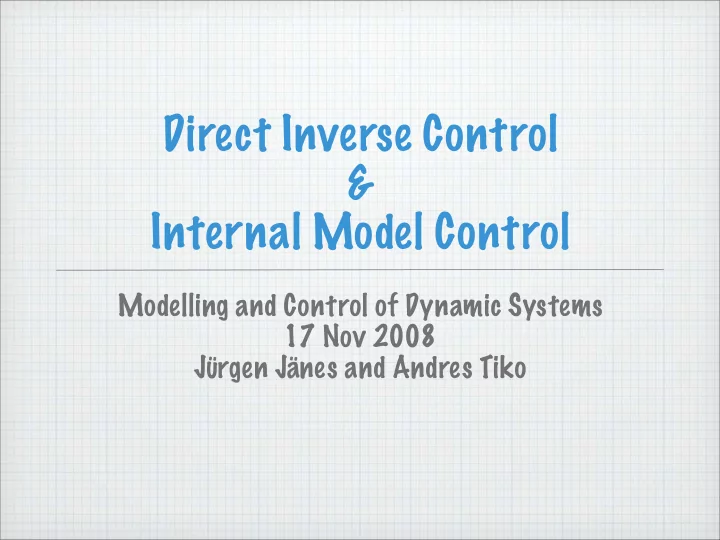

Direct Inverse Control & Internal Model Control Modelling and Control of Dynamic Systems 17 Nov 2008 Jürgen Jänes and Andres Tiko
Talk Outline Introduction to Control Direct Inverse Control General Training Specialized Training Demo Internal Model Control
Introduction Book so far: System identification “How does the system behave?” Book from now on: System control “How do I make the system do what I want?”
Taxonomy of Control Problems Regulation problem: keep the output of the system at a constant level e.g. room temperature, inverted pendulum Servo problem: make the output follow a desired trajectory e.g. brick doing 8-shapes on a tiltable plane
Stability in practice, nonlinear systems need to be stable for successful control altough transfer functions don’t apply for nonlinear systems, “transfer function zeroes” are extended to nonlinear systems details: Section 3.7 (Nov 24th) on-line training/adaptive control: approach with a grain of NaCl
Control system architectures direct control system: neural network is the controller + simple implementation - parameter change -> retrain network indirect control system: use a neural network as a (cheap!) system model + faster controller “tuning cycle” - more complicated to implement
Benchmark system “ spring-mass-damper system with a hardening spring” open-loop stable inverse is unstable
Direct Inverse Control (DIC)
DIC: Basic Idea Train a neural network as the inverse of a system, use this as the controller System is described by We make the neural network learn
DIC: time delays Assuming the model is governed by We would like to train the network to learn But we don’t know
DIC: time delays (2) Solution #1: this is a system identi-fication task! Solution #2: “incorporate” inverse model directly (assume d=2 -> y(t+1) missing) Assuming y(t+1) can be precicted with Train the network with (=add more past data)
General Training Train the network using “brute force” , i.e. minimize: can directly use any method from Section 2.4
Practical Considerations essentially, DIC produces dead-beat controllers -> feedback is used to achieve fast response time poor robustness, high sensitivity to noise and high frequency disturbances
Practical considerations 2 it has been shown that a discretization of a continuous linear system can have zeros near the unit circle (=is unstable), regardles of how the zeros in the continuous system are placed similar behaviour expected in the nonlinear case
Practical considerations 3 System is not one-to-one Might work if non-uniqueness is not reflected in the training set
Practical considerations 4 identification for control: training data should be similar to testing data but we don’t know how the system responds to the NN controller solution: iterative training
Benchmarking Linearized+discretized system has a zero at z=-0.9354 (near the unit circle) -> large+oscillating control signal Solution: low-pass filtering of reference
Specialized Training General Training: minimises error between network output and “true” control input We would like to minimise error between system output and reference signal
“Deriving a training scheme based on this criterion is not completely straightforward. A few approximations are required to make implementation possible.”
Our for this Proof recall from Analysis - The Chain Rule: Given that x 1 =x 1 (t), ..., x n =x n (t).
Implementation specialized training can be implemented by slightly modifying algorithms from Section 2.4 details in book
Summary Generalized training. Off-line, minimize RMS between experimentally determined control signal and predicted control signal Spezialized training. On-line, minimize RMS between reference signal and system output
DIC recommended approch 1. Generate data set from experiment 2. Generate forward model 3. Initialize controller with general training 4. Specialized training on system model (off-line) 5. Specialized training on real system (on-line) 6. (Profit!)
DIC: the good + intuitive & simple to implement + controller can be optimized for specific trajectory with specialized training + in theory, should work on time-varying systems
DIC: the bad - does not work for systems with unstable inverse - problems when system is not one-to-one - problems with inverse models not well-damped - lack of tuning options (parameter change -> retrain network) - high sensitivity to disturbance & noise
End of Part 1.
!"#$%"&'()*+$'(,*"#%*'(-!),. ! /(+$012"(3'*0$'4(3*""$3#$+(#*(+1%$3#(1"5$%0$( 3*"#%*' ! 6$0#%13#15$(%$781%$9$"#0(#*(#:$(3:&%&3#$%10#130( *;(#:$(040#$9 ! <*9$("13$(;$%$0(=(3*9>$"0*"(;*%( 3*"0#&"#(+10#8%?&"3$0 ! !
!"# ! $%&'()%*+,+-.)/,)0+1.0%2+,*+/%22+,*+,3+ (34%)*%+1.0%2+.-+56%+*7*5%1 ! 8%%09,:;+:.3*(*5*+.-+56%+%)).)+9%5/%%3+ *7*5%1+.'5<'5+,30+1.0%2+.'5<'5+=+>%).+-.)+,+ <%)-%:5+1.0%2 ! !
! !
!"# % % &' ( $ ! ! " "# # ! " "$ & * ! " "% # ! " "' % % &' ! ( % ) " " $ $ & ' + ! " "# & * ! " "% # ! " "' % % & ' ! ( % ) " " $ $ ! !
!"#$%&%"' ! ()*+,&)$#&+-"#$%&%"'+).+"/0+1&)-02+&))3+-'-"04+ "/0+-'-"04+")+$0+1)5"*)&&02+#52+"/0+%560*-0+ 4)20&+-/)7&2+$)"/+$0+-"#$&0 ! 8097%*0405"+).+)305:&))3+-"#$%&%"'+-060*0&'+ &%4%"-+"/0+1&#--+).+-'-"04-+"/#"+1#5+$0+ 1)5"*)&&02+;%"/+<=> ! !
!"#$%&#'($)*+(& ( ,-&#+$.&#'(./#&$0*-&.1.*-23$4$5$6$'-&$7$5$6 89 ! ! " "# # $ $ % ! " "% & ! " "& % ) # % ! " "'! " % ( % ) # " & ! " " ' ! " "# ( ! !
!"#$%&'()*()+"(,-.)"/ ! ,(-'()+"(*%.0(&"'-1%(2$/$#")"/3()+"/"4*/"(-)(-'( &-44-56.)()*(-#2*'"(5*%')/$-%)'(*%()+"(5*%)/*.( '-1%$. ! 76')(8"(')$8."($%&(+$9"(6%-)0(')"$&0:')$)"( 1$-%()*("%'6/"()/$5;-%1(*4()+"(/"4"/"%5" ! ,*/(&-')6/8$%5"(/"<"5)-*%($8-.-)03(-)('+*6.&(+*.&( )+$)(=>:? :& ,@(9=)@(A(B ! ,(A(>(-'($(1**&(5+*-5" ! !
!"#$%&$'()*%+,--- ! .//&)01/2))$2)&(34&)$/32$&5&0)6&$+//)*0)7$85$ *34&0+40$7%&0928+4*) ! :);9%2)6)40$0<+0$0<)$&5&0)6$%&$3()41,33($ &0+8,) ! =%//%*9,0$03$)4&92)$0<+0$0<)$%4>)2&)$637),$%&$ 02+%4)7$34$+$2)+,%&0%*$7+0+$&)0 ! !
Recommend
More recommend